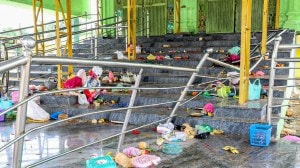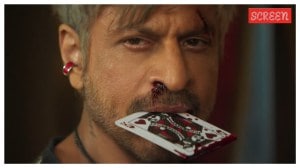The Dalit evangelists
Seventy years after Dalits were first allowed to enter temples in Kerala,a new movement that exhorts Dalits to break away from Hinduism and embrace Buddhism as a religion and BR Ambedkar as god,is gaining many followers,reports Shaju Philip....
Its 9 at night and men stand guard at every turn along the narrow path that leads to the Dalit colony spread over a hill at Kaippattimukku near Attingal in Thiruvananthapuram district in Kerala. Inside one of the houses,a woman in a black t-shirt with a photograph of BR Ambedkar printed on it walks towards the group of women sitting on the floor and addresses them.
We,Dalits,spend our hard-earned money for watching movies in theatres. But have you ever seen a movie that makes a Dalit proud? Have you ever seen an SC/ST woman on a film poster? asks Pallimon Sandhya.
Women,mostly farm workers,nod in agreement. Sandhya continues,Political parties do not allow Dalits to grow into leaders. We have been destined to fill grounds where leaders address the public. Dont you think a change is needed?
Sandhya is one of the 2,000-odd new generation Dalits evangelists who under the Dalit Human Rights Movement (DHRM) is exhorting Dalits to explore their identity and create their space in society.
At houses belongings to Dalits and tribals,DHRM preachers talk to people on how Dalits have been victimised over centuries by the caste and sub-caste system and on the need for a social rebirth. After the first class,members in a colony are put on to a 72-hour-long indoctrination session.
These sessions veer around topics like backwardness among Dalits,the need to discover the Dalit identity,ways to regain the Dalit individuality,nurturing the habit of thrift,weaning the community away from alcohol and the necessity for breathing life into Dalit folklore and ethnic music.
A Dalit outfit with an unprecedented cadre culture,the DHRM is different from other Dalit organisations that tend to stick to issues regarding reservation and land. In the two-and-a-half years that its been around,it has been gradually gathering support. Ten thousand families have joined the DHRM,which claims its message has so far reached three lakh Dalitsit distributes amongst the community about 30,000 copies of the weekly newsletter.
In the past,a number of social movements in Kerala foughtand wonfor Dalits the right to enter temples and equality with upper class Hindus. The Vaikom Satyagraha of 1924-25 played a crucial role in winning Dalit rights in the country. Where Dalits were once not allowed to even use the road near the Shiva temple at Vaikom in Kerala,the agitation resulted in the approach roads to the temple being opened for Dalits. Following this came the Temple Entry Proclamation of the erstwhile princely state of Travancore (now South Kerala) in 1936,which allowed Dalits to worship in all temples.
But 70 years after that watershed moment,a movement to call Dalits out of temples is gaining momentum in a state where Dalits constitute 9.8 per cent of the population. The DHRM is not interested in getting Dalits their place in Hindu society. Instead,they advocate a complete break from Hinduism. So,calling the Hindu caste system the biggest oppressive machine,the DHRM has embraced Buddhism as its religion and Dr B R Ambedkar as its god.
Signs of change are now there at the ghettoes where the DHRM has gained control. In houses of the groups activists,pictures of Hindu Gods and Goddesses that had graced the walls for generations,have been replaced with photographs of Ambedkar.
Some DHRM families pray to Ayyankali,a social reformer of the last century who worked for the rights of the Dalits. They have stopped going to temples and offering rituals. Customs performed at the occasions of birth,marriage and death are held according to Buddhism.
FLOATED as a charitable organisation in 2007 at Paravoor near Kochi,the DHRM was formed after a group of Dalit leaders who had worked in various political parties and Dalit outfits,regrouped and got together. Its chairman V V Shelvaraj,29,had been an active worker with the BJP,another founder and South Kerala organiser Varkala K Das is a former member of an CPI (M) area committee.
The DHRM envisages freeing Dalits from the clutches of the caste system. Hence,we have embraced Buddhism,which Ambedkar followed. Besides,Buddhism was identified as the religion to regulate the undisciplined Dalit life, says Das.We want to break the shackles of the caste structure and organise the community democratically, he adds.
A Dalit becomes a DHRM activist only when a person realises that he or she is not a Hindu. We are facing the charges of extremism from police and the mainstream political parties because we teach Dalits to abandon Hinduism. But our activists will not sport any Hindu identity, says Das.
To help Dalits value their traditions and culture,the DHRM promotes folklore and music. We have only disgust towards the dance forms such as Mohiniyattam which belongs to the upper class Hindu tradition, says Das.
The organisation also tries to foster a sense of belonging among members. So,members address each other as brothers and sisters and eat together at functions with their families. In fact,unlike other movements which woo only the youth,the DHRM strives to draw families into its fold. Its appeal to members to quit smoking and drinking has gone well especially with women.
Rajan N,a farm worker,who joined the DHRM,had abandoned the routine visit to the local temple. The money I gave to the temple,I now give to the DHRM fund. I strongly believe that the movement will make the lot of the next generation better.
AS Dalits in Kerala get mobilised under a new banner,political parties in the state are beginning to get worried. In south Kerala,where Dalits are traditionally CPI (M) voters,several Dalit grassroot workers of mainstream political parties are shifting allegiance. Many of them say they moved to the DHRM,after they realised that political parties would continue using them for small jobs and for carrying out violent activities but would never share power with them.
CPI (M) secretariat member and Attingal MLA Anathalavattam Anandan admits their vote bank is shrinking. The DHRM is working to weaken the Left vote bank. With the DHRM wooing the Dalits,the Dalit vote will split and this will hit the Left, he says.
Meanwhile,Hindu organisations and other Dalit movements in the state too are beginning to feel the heat. Several Shiv Sena and BJP members have left and joined the DHRM. Hindu Aikya Vedi state secretary R V Babu alleges that the DHRM gets support from the Islamic world. The National Development Front (NDF) and the Jamaat-e-Islami had the tradition of extending their support to the Dalit politics to use the community as a hitting tool, he says.
DHRM members,meanwhile,complain of being harassed by both the Left and the Shiv Sena. According to Das,the CPI (M),BJP and Shiv Sena have brutally attacked members. These parties have realised that the Dalits who have joined the DHRM would not act as per their directives. Fearing attacks from political parties,our men have to guard people when our classes are held.
At Munambam near Kodungalloor,siblings Shinsa and Shansa who belong to a CPI (M) family,are active DHRM workers. Several men in the region had gone into hiding after the police harassed them on charges of terrorism, says Shansa.
State intelligence sources admit that Dalits under the DHRM have emerged as distinct bloc. In the past,the Congress and the CPI (M) used to dispatch trucks to colonies fetch the Dalits for party functions. This has stopped happening in colonies where DHRM calls the shots. Also the consumption of liquor,which was high in these Dalit settlements,too has come down significantly, sources say.
Some in the state say the DHRM is being helped by the right-wing Muslim outfit Popular Front of India (PFI),which had floated a political party,the Social Democratic Party of India.
Says PFI senior leader Nazeerudheen Elamaram,What is wrong in supporting an outfit which struggles to regain the Dalit identity. The CPI (M) and the Shiv Sena have joined hands to destroy the Dalit wave.
Das,however,says the DHRM was propagating a hardcore identity for Dalits and would not allow the PFIs dream to build a Muslim-Dalit plank to be realised. The DHRM,he adds,would field its own candidates in the coming elections to the local bodies.



- 01
- 02
- 03
- 04
- 05




























